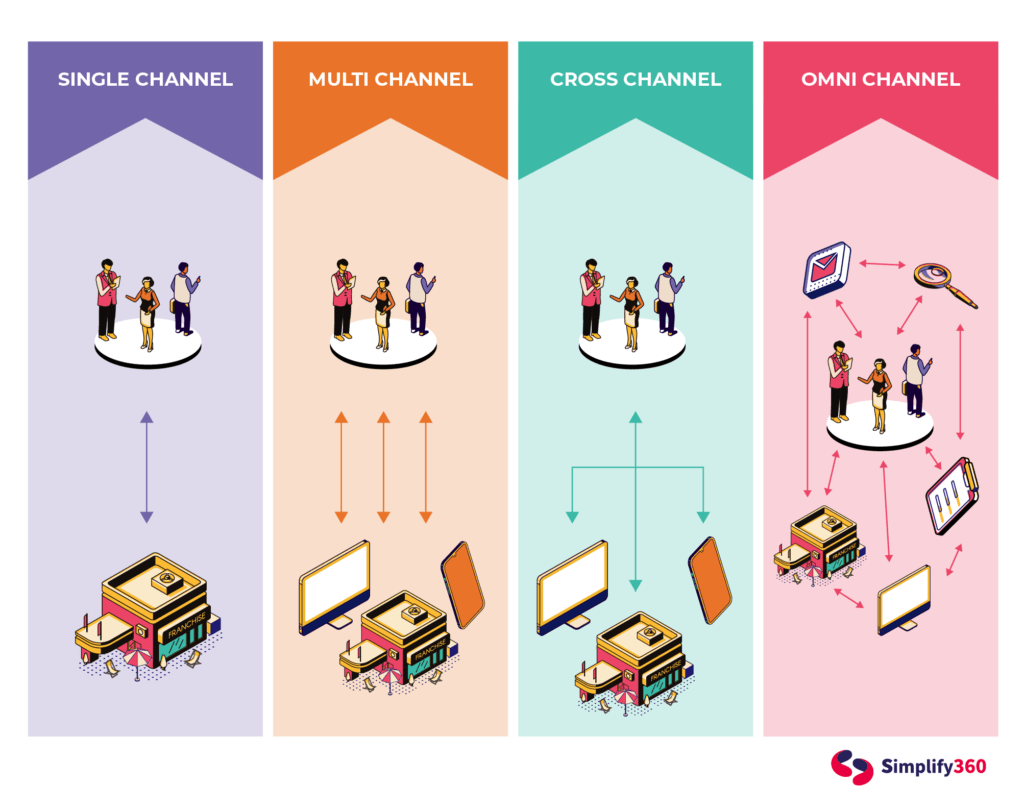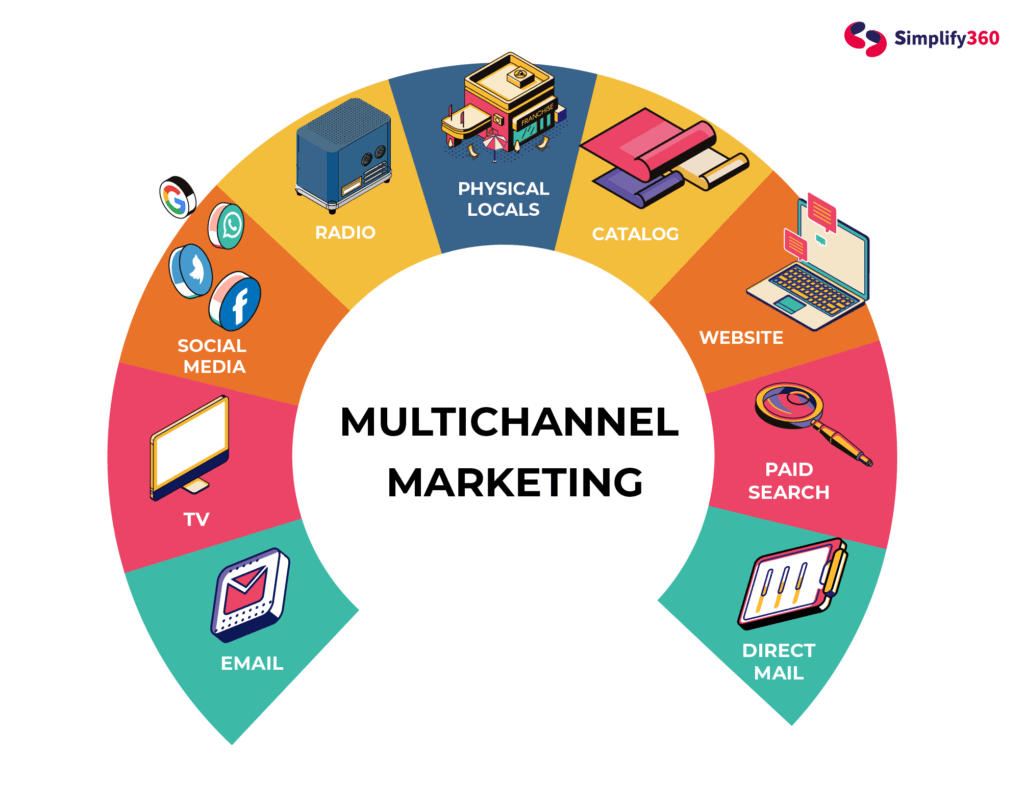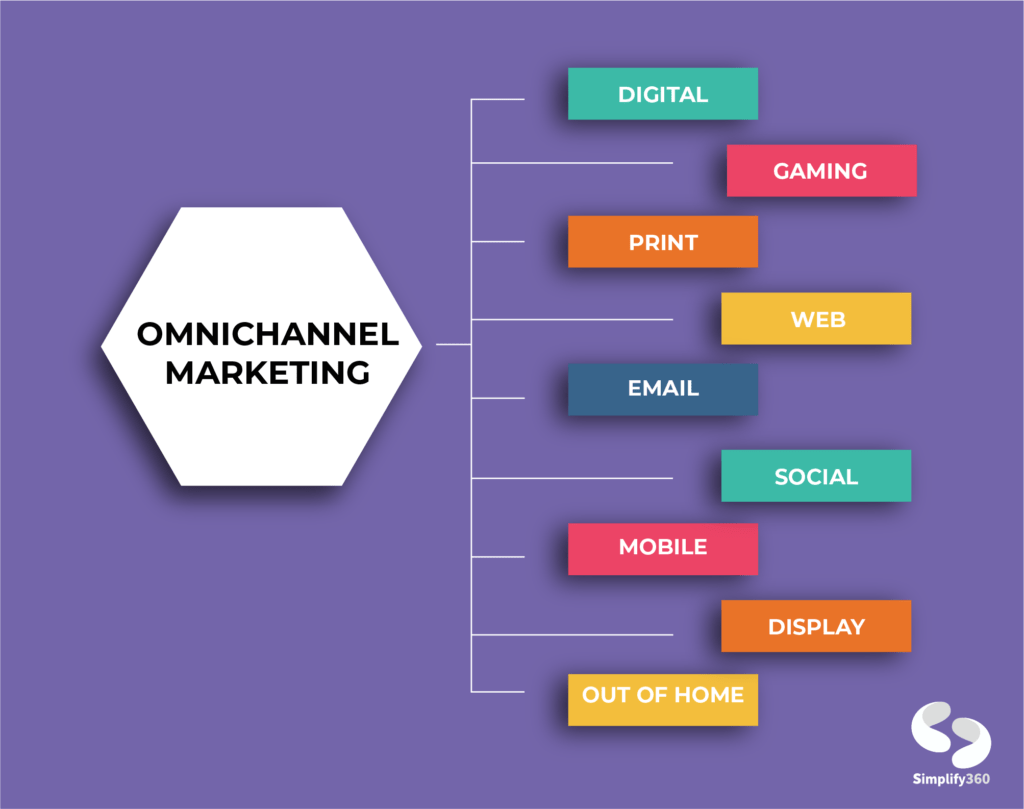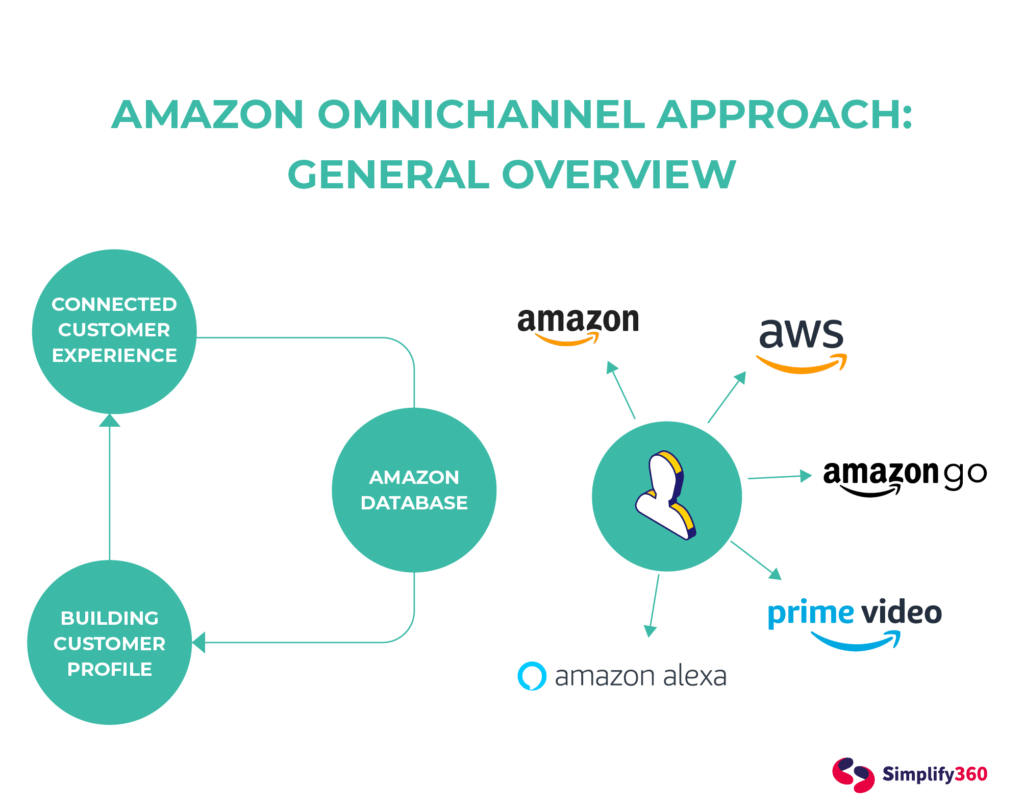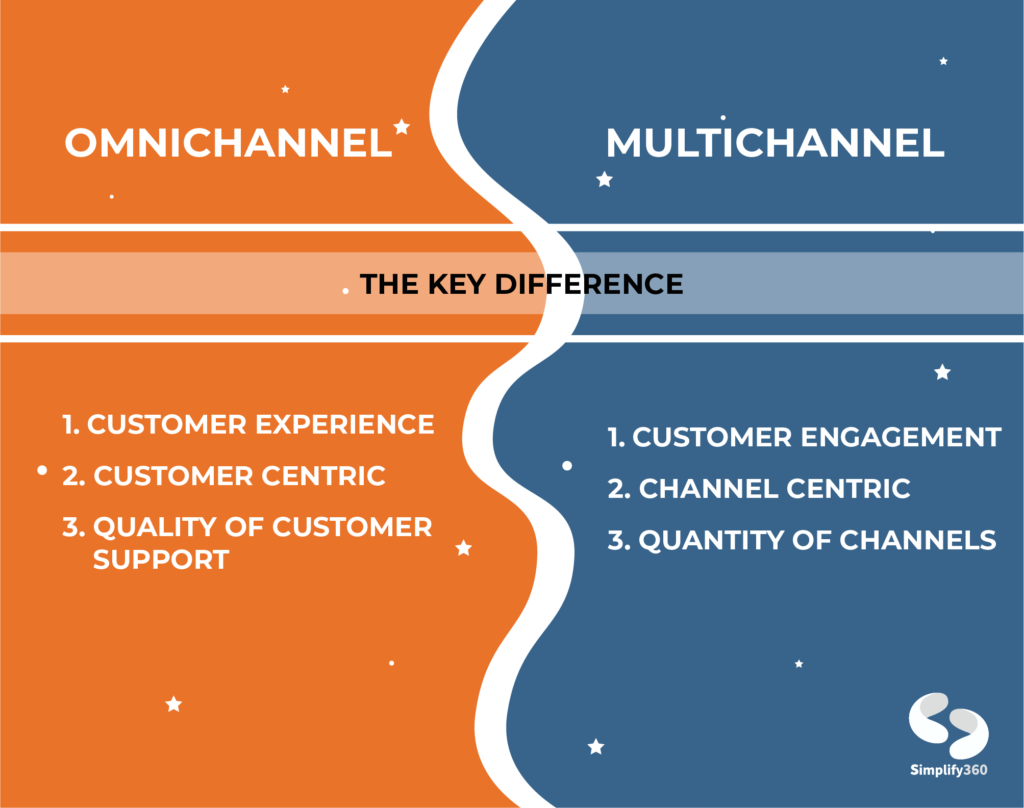We often come across articles that praise the omnichannel approach over the multichannel that’s because companies with strong omnichannel customer engagement were recorded to retain almost 89% of their customers!🤯
If nothing else, this statistic alone is enough to know the rising demand for the omnichannel strategy. But is this all that makes omnichannel strategy better?
Various reasons denote the importance of omnichannel eCommerce today. And, some of these are more tempting than retaining customers.
Well, you guessed just right! This blog will talk about the benefits of an omnichannel platform. However, instead of discussing regular benefits, we will introduce you to various types of channel-based marketing strategies. And, what makes omnichannel marketing strategies stand out among these? So, let’s begin.
Types of Channel-Based Marketing Strategies
In the past few years (read the pandemic years), the world has witnessed a shift in marketing strategies. We can no longer stick to single-channel marketing. This shift isn’t radical though. For some time now, the world has been shifting to digital marketing.
But, what initiated this shift? The digital boom of course!
The advent of computers and mobile phones has changed the ways of customer engagement strategy. Today, the customer is everywhere. Studies show that almost 98% of customers switch between multiple devices, on a single day.
If your customers are this trendy, how can you use an outdated marketing plan?
As a result, three marketing approaches emerged
- Multichannel
- Cross-Channel
- Omnichannel
With their own set of advantages and disadvantages, all three will help you evolve and improve customer experience. More importantly, they enable you to reach your customers everywhere!
Let’s see what these are in detail.
1. Multichannel Marketing: Multiple, Disconnected Channels
“Multichannel marketing means using multiple channels to reach customers at some point in their customer journey.”
The multichannel approach means independence for each channel. None of the channels have communication between them. The channels here can be direct or indirect. For example, direct approaches like phone sales, mail, online display ads, etc; or indirect approaches such as online reviews, social media fan pages, news articles, etc.
In simple words, multichannel involves separate channels.
2. Cross-Channel Marketing: Multiple, Connected Channels
“The ability for brands to connect with customers on various communication channels in an ideal, cohesive manner is known as Cross-Channel Marketing.”
The cross-channel approach differs from the multichannel strategy in only one way: the channels in cross channel approach are connected.
It ensures data storage. It allows your customer conversations to be stored and enables channels to communicate this data freely between them.
In other words, a cross-channel approach means a better customer experience.
3. Omnichannel Marketing: Multiple, Interconnected Channels
“Omnichannel marketing refers to a brand’s interaction with customers across multiple online and offline channels, aimed at providing a consistent customer experience.”
The best way to understand omnichannel strategy is to look at it as a combination of multi-channel and cross-channel.
This is for two reasons
- Involves multiple channels, just like the multi and cross-channel approach.
- Connected channels, just like in cross-channel marketing.
So what makes omnichannel go beyond the above two? What enables it to provide customers with a seamless experience?
In an omnichannel approach, multiple channels are connected as well as interconnected and interactive. This enables channels to exchange information about the customer journey. This allows maximum customer engagement.
In other words, an omnichannel strategy ensures a seamless and comprehensive user experience.
Cross Channel vs. Omnichannel vs. Multichannel
By now you must have a basic understanding of these marketing strategies. Let’s now understand the difference in their functioning. And, let’s do this with the help of Chris – our hypothetical modern customer for this article.
Chris wants to buy a new pair of shoes. He came across one in a catalog that he received in his mail. He looks up the brand online to look for online reviews. At this point he realizes, he has also received a discount coupon in his email. Excited by the offer, he begins his online shopping experience.
However, an urgent work call disrupts him and he leaves for work without making the payment. He tries to complete the process during his break.
Now let’s see how different marketing approach impacts Chris.
Multichannel Strategy
With a multichannel approach, brands cannot save customer data.
This is because multi-channel marketing lacks connected channels. As a result, as soon as the customer logs out, their data is wiped out.
Therefore, here Chris is needed to start his purchasing process from the scratch.
Cross-Channel Strategy
A cross-channel strategy allows channels to communicate with each other. This enables brands to gather data on customer behavior and purchase pattern.
Therefore, here Chris will be able to retrieve his shopping cart, whenever he would want. Not only this, but he will also receive a reminder email that he has items in his cart. To top this, after completing the purchase, he would also receive a thank you message along with a discount coupon for the next purchase.
Omnichannel Strategy
The omnichannel approach enables your system to remember the customer. In other words, it provides you with a tailored dashboard, unique to each customer.
As a result, you are facilitated to provide customers with a personalized experience.
Therefore, Chris on his next visit will be welcomed with a personalized dashboard. This dashboard will have recent promotions and recommendations, based on her previous purchase. Moreover, his offline shopping experience will be enhanced. This is because the physical store of the shoe brand will be interconnected with the website he made the purchase online.
For easy understanding, and to understand the importance of connected channels, this blog will focus on the omnichannel and multichannel approaches.
Understanding Multichannel Approach
We believe a basic understanding of multichannel strategy is already delivered. In this section, we will explore the depths of the following concepts.
A few important topics we will explore are
- Brands that Utilize
- Multi-Channel Approach
- Benefits of Multi-Channel Retailing
- Disadvantages
Without any further ado, let’s begin.
What is Multichannel Marketing?
“The multichannel approach is a marketing practice that involves more than one media channel to communicate with customers in a disconnected manner.”
The channels range from TV ads to online display ads. However, as mentioned earlier, all the channels work in a disintegrated manner. The content and style used on one platform will differ from another. For example, the campaigning style used for Facebook will not be the same as Pinterest.
Wondering why?🤔
A separate communication channel enables you to put your product or service at the center. Since each channel functions separately, customers visit different channels for different products.
Simply put, every channel in multichannel marketing exists as a separate sales opportunity.
So multi-channel isn’t necessarily all bad. Let’s look at some of its benefits.
Benefits of Multichannel Retailing
As a modern marketer, you must understand the importance of meeting customer requirements.
The success of your brand doesn’t depend entirely on your product or service. Consistent customer experience is at the heart of modern marketing.
Top brands strongly strive to improve customer relationships. They aim for an effective, engaging, and fulfilling customer experience. And voila, you get more sales!
In other words, your marketing and advertising must create a positive UX experience.
A multichannel marketing strategy fosters consistent brand experience. It helps you deliver a positive customer experience by providing separate spaces for separate products. This works especially well when your brand caters to more than one product.
Here are the top 5 brands that thrive using the multichannel approach.
Before we move to discuss its drawbacks, let’s have a look at how Apple thrives with a multichannel strategy.
Apple and Multichannel Retailing
Over time Apple observed that most of its consumer electronics sales came directly from websites or third-party sites. This inspired the company leaders to reinvent their in-store customer experience.
Today, Apple’s website and mobile app offer purchasing space. And, the physical stores offer demonstrations, education, and technical support.
Hence, when the customer is ready to make a purchase they can do so either in-store or online. This is because the mobile application maintains all records of previous customer engagement.
Another factor that ensures Apple’s success is its consistent brand messaging policy.
Irrespective of the channel used, customers can easily identify apple content. Therefore, consistent brand experience is prioritized above uniform brand experience.
So where does it lack? If America’s largest revenge-generating company thrives using a multichannel approach, why does the omnichannel approach takes precedence?
We can understand this with the help of the drawbacks of the former.
Pitfalls of the Multichannel Approach
There’s no denying that the multichannel approach can increase your sales and exposure. But that doesn’t mean it comes without any drawbacks. As we mentioned in the beginning, the biggest drawback of multi-channel marketing is having disintegrated channels. This means the customer data hardly gets stored.
Unless your brand is as big and reputed as Apple, the customer will forget about your product!
But that is not the only reason to think multiple times before investing in it. Have a look at these reasons that will make you reconsider choosing a multi-channel marketing platform.
1. Increased Sales Cost
Once you add online sales, you need to hire extra staff to serve customers. Working with different platforms requires different advertising and marketing efforts.
A multi-channel approach does not offer integrated channels. This means your sales cost to cater to all the mentioned above will surely go high.
2. Risk of Misinformation
The internet is a diverse and open space. It allows everyone to publish content. This often leads to malicious and fake reviews. Since your channels are not integrated, it becomes difficult for your marketing team to keep a tab on online reviews.
Therefore, with multichannel retailing, you must ensure that only company-approved information is being passed.
One way you can avoid this is with consistent brand messaging (like Apple’s).
Reading between the lines, these reasons tell how interconnected channels ease things.
Moving on, let us throw some light on omnichannel marketing.
Understanding Omnichannel Marketing
As mentioned before, omnichannel marketing involves multiple interconnected channels, all working together to provide a seamless experience. But, how did this interconnectivity make it the choice of almost 80% of consumers today?
This is exactly what we will explore in this section.
So let’s begin.
What is an Omnichannel Marketing Strategy?
It is no news that omnichannel also operates via multiple channels for customer engagement. But, it is one major key difference that sparks the omnichannel vs. multichannel debate.
Omnichannel platforms are integrated. This enables your customer to seamlessly move between channels.
Think of a car moving seamlessly on a race track! That’s exactly what an omnichannel platform makes your customers feel like.
In a more technical approach, it may be defined as,
“The integration and cooperation of various channels that enable businesses to interact with customers.”
As you can tell, the goal here is to create a consistent brand experience.
An omnichannel marketing strategy focuses on creating a convenient, seamless user experience. This offers consumers various opportunities for satisfaction.
With an omnichannel approach, your customers can integrate their purchase – “buy online and pick up in-store”. This is because it facilitates the integration of your digital (websites, games, emails, etc) and physical (stores) touchpoints.
And, with this integration comes various benefits.
Benefits of Executing Omnichannel Retail
Today, the omnichannel retail strategy is used across industries. Some of the top industries using it are – finance, technology, and healthcare.
The biggest marker of having an omnichannel strategy is providing a customer-centric service.
Following are some of the features that omnichannel retail strategy enhances.
1. Better User Experience
As mentioned above, the omnichannel strategy focuses on customer experience, more than channels. As a result, your customers can access a better, and more personalized experience.
This provides them with a better user experience. Each customer’s data is stored in the database which is then used to provide them with tailored suggestions.
2. Cohesive Brand Strategy
We have talked so much about a seamless strategy across channels. But, what does it exactly mean?
It means building an identifiable brand image and tone.
When all the channels are connected, they work uniformly. Moreover, it does not ignore the unique identities and needs of every customer.
Therefore, a successful omnichannel strategy focuses on an overall experience.
An omnichannel customer experience software works within your brand guidelines and incorporates user purchasing history. This means it can collaborate both (when needed) and help you maintain a cohesive brand strategy.
3. Increased Revenue
Good user experience alongside a unique brand tone is the perfect recipe for customer retention.
And, when you retain customers, you already have the means to increase your revenue. But, let’s throw a little more light upon this.
An omnichannel approach encourages customers to engage with your brand multiple times. It keeps the customer coming back for more. Why? Because of a personalized user experience, of course!
When a customer engages with the same brand multiple times, this is what happens
- Increased, diverse engagement at each stage
- Provides data for targeted messages
- Facilitates better marketing ideas
Let’s understand this with the help of Amazon’s marketing efforts.
Amazon and Omnichannel Marketing
Amazon is one of the biggest online marketplaces. Its mission to be “Earth’s most customer-centric company”, makes it one of the best examples of the omnichannel strategy.
Amazon’s primary focus is, thus, customer experience.
They use customer engagement data to create personalized and responsive interaction. And the value held by the medium used is little to none. Second, all their channels are integrated into the backend. This enables them to serve the customer via every sales channels.
Therefore, Amazon customers can place their orders vocally. The Wi-Fi Amazon Dash Button enables you to order anything with a click, irrespective of the medium used.
And now you know what goes on in the backend after you click that payment button!😉
Omnichannel vs Multichannel – The Debate
By now we have discussed all that is there to be discussed about omnichannel and multichannel platforms. And, one thing we can take away is having your communicative channels integrated is of utmost importance.
Therefore, while multichannel marketing can help you improve customer engagement, it misses out on providing a better customer experience.
The fundamental reason behind the failure of multichannel marketing is the absence of interconnected channels. When your marketing effort involves multiple channels, the sales cost is sure to go up. And, only when all your touchpoints work together that you can make some profit.
An omnichannel platform, on the other hand, enables you to focus solely on customer experience.
Take Simplify360 for example.
With us, you can deliver an AI-powered customer experience. We provide you with features such as customizable dashboards, comprehensive and detailed insights, and the best man-machine collaboration. All of these together, help you deliver a holistic fullied experience to your customers.
Final Statement
And just like that we have reached the end of our blog.
The bottom line here is you must invest in an omnichannel eCommerce today.
If there’s anything that the omnichannel vs multichannel debate teaches us, its that the omnichannel approach is here to stay.
If you’re a business in its nascent phase, sure multichannel can help you. But this is because of the lack of multiple channels and their inactivity. As your business grows, you are required to incorporate as many channels as possible. This is when you cannot ignore investing in an omnichannel marketing strategy.
But don’t worry, We will soon be back with the most exciting industry topics for you. Till then, Au Revoir!


